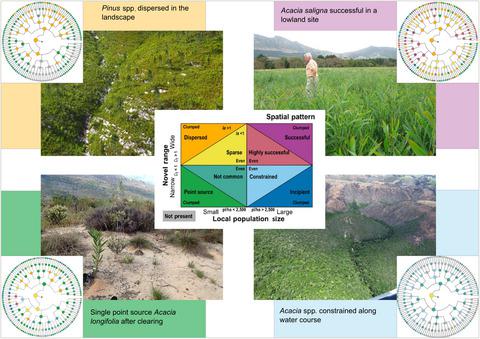当前位置:
X-MOL 学术
›
J. Appl. Ecol.
›
论文详情
Our official English website, www.x-mol.net, welcomes your feedback! (Note: you will need to create a separate account there.)
Quantifying range structure to inform management in invaded landscapes
Journal of Applied Ecology ( IF 5.7 ) Pub Date : 2020-10-19 , DOI: 10.1111/1365-2664.13765 Chad Cheney 1, 2 , Nicola J. Wilgen 3, 4 , Karen J. Esler 2, 3 , Llewellyn C. Foxcroft 3, 5 , Melodie A. McGeoch 3, 6
中文翻译:

量化范围结构以告知入侵景观管理
更新日期:2020-10-19
Journal of Applied Ecology ( IF 5.7 ) Pub Date : 2020-10-19 , DOI: 10.1111/1365-2664.13765 Chad Cheney 1, 2 , Nicola J. Wilgen 3, 4 , Karen J. Esler 2, 3 , Llewellyn C. Foxcroft 3, 5 , Melodie A. McGeoch 3, 6
Affiliation

|
- The negative impact of invasive alien plants (IAPs) in protected areas (PAs) is managed through control programmes, often using area‐based management, where identified IAPs in management units are controlled simultaneously. However, this approach has shortfalls, including the methods used to prioritise management units, spatial grain dependence and spatial interdependence of management units. Species‐based management approaches, though used less frequently, are usually aimed at eradication.
- We propose using a Commonness framework to reconcile area‐based and species‐based management approaches, viewing the invasion process as a population trajectory from uncommon to common. The framework assigns species to one of eight commonness types at a given scale using three species characteristics: local population size (small/large), geographic range (wide/narrow) and spatial pattern (even/clumped). These metrics were calculated using a comprehensive fine‐scale IAP dataset from Table Mountain National Park, South Africa, at six scales of increasing spatial grain, enabling quantification of the effects of scale and species' range structure on management potential of IAPs.
- Most species exhibited the Point Source commonness type at fine spatial grains, requiring Rapid Response, Reconnaissance or Sweeping management strategies. At coarser grains, species were mostly classed within wide occupancy ranges, with small population sizes (Dispersed and Sparse types). The Control strategy currently applied in the area (best suited for large populations across a narrow range) should be re‐evaluated given the progress made by historical clearing in reducing commonness. Using a phylo‐tree, we identified adjacent areas that require different strategies as well as changes in species‐specific goals at particular sites with increasing grain coarseness. For example, species generally deemed to be common, for which a Control strategy is applied, may require Rapid Response type strategies for isolated and/or small, clumped subpopulations.
- Synthesis and applications. We use a Commonness framework to quantify patterns of plant invasion at multiple spatial scales. We demonstrate how different management strategies are appropriate for the same species in different parts of its invaded range, and how these nuances are often obscured through the use of coarse data. The framework enables tailoring management interventions to minimise the spread and impact of invasive alien plants.
中文翻译:

量化范围结构以告知入侵景观管理
- 入侵性外来植物(IAP)对保护区(PAs)的负面影响是通过控制计划来管理的,通常使用基于区域的管理,其中管理单位中已确定的IAP被同时控制。但是,这种方法存在不足,包括用于对管理单元进行优先级排序的方法,管理单元的空间粒度依赖性和空间相互依赖性。基于物种的管理方法虽然使用较少,但通常旨在根除。
- 我们建议使用“共性”框架来调和基于区域和基于物种的管理方法,并将入侵过程视为从不常见到普遍的人口轨迹。该框架使用三种物种特征在给定的规模上将物种分配为八种常见类型之一:本地种群大小(小/大),地理范围(宽/窄)和空间格局(均匀/成簇)。这些度量标准是使用来自南非桌山国家公园的全面,精细的IAP数据集,以六种增加的空间粮食尺度进行计算的,从而可以量化尺度和物种范围结构对IAP管理潜力的影响。
- 大多数物种在精细的空间粒度上表现出点源共性类型,因此需要快速响应,侦察或清扫管理策略。在较粗的谷物中,物种大多数被归类为在较宽的居住范围内,种群数量较小(分散和稀疏类型)。鉴于历史上为减少共同性而进行的清理工作所取得的进展,应重新评估该地区目前适用的控制策略(最适合窄范围内的大量人口)。通过使用系统树,我们确定了需要不同策略的邻近区域,以及在特定地点随谷物粗度增加而改变物种特定目标的区域。例如,通常认为对其实施控制策略的常见物种,可能需要针对孤立和/或小型,
- 综合与应用。我们使用“通用性”框架来量化多个空间尺度上的植物入侵模式。我们证明了不同的管理策略如何适合其入侵范围内不同部分的同一物种,以及如何通过使用粗略数据来掩盖这些细微差别。该框架使定制的管理干预措施能够最大程度地减少外来入侵植物的扩散和影响。


























 京公网安备 11010802027423号
京公网安备 11010802027423号